Abu'l-Hasan | |
|---|---|
 | |
| Born | 1589 |
| Died | 1630 |
| Style | Mughal |
| Patron(s) | Jahangir |
Abu'l-Hasan (or Abu al-Hasan; 1589 – c. 1630), from Delhi, India, was a Mughal painter of miniatures during the reign of Jahangir.
Abu'l-Hasan | |
|---|---|
 | |
| Born | 1589 |
| Died | 1630 |
| Style | Mughal |
| Patron(s) | Jahangir |
Abu'l-Hasan (or Abu al-Hasan; 1589 – c. 1630), from Delhi, India, was a Mughal painter of miniatures during the reign of Jahangir.

Abu al-Hasan was the son of Aqa Reza Heravi of Herat in Safavid Iran, a city with an artistic tradition. Aqa Reza was established as an artist and took up employment with Jahangir (r. 1605 –1627) before the latter's accession to the throne of the Mughal empire. [1] When Abu al-Hasan began producing art, the emperor, Jahangir, appreciated the skills of the boy. [2] In 1599, Abu al-Hasan moved with Jahangir to his newly founded court in Allahabad. [3]
The emperor considered Abu al-Hasan to be particularly special to him and under his care. [1] This is because although Abu al-Hasan's artwork was similar in many ways to his father's with Dutch and English influence, it was considered to be of a higher quality similar to that of older masters in the field. [1] [2] Jahangir said of Abu al-Hasan that he had no equal and for the work done on the frontispiece for his memoires, the emperor bestowed the title Nadir-uz-Saman ("Wonder of the Age") on Abu al-Hasan in 1618. [4]
Abu al-Hasan's main task was the documentation of events at the imperial court, which resulted in many portraits being completed. Portraits were the hallmark of Jahangir's rule. [5] Not many of Abu al-Hasan's paintings survived, but those that identify him as the artist show that he also worked on a range of subjects, including some everyday scenes [6] and political paintings that showed the emperor and Mughal empire in a positive and powerful light. [7] In addition to original works of art, Abu al-Hasan also retouched other artists' paintings (one such example is below: Dancing Dervishes) [1]
Abu al-Hasan's career aligned with developments in the style of Mughal paintings. [1] However, when Jahangir's reign came to an end, and Shah Jahan began his rule, Abu al-Hasan's career became less active until 1628 from which point on, there is no evidence of him producing art. [4]
| Title | Year | Current location | Notes | Material |
|---|---|---|---|---|
| Study of Saint John the Evangelist, After Albrecht Dürer | c. 1600 –1601 | Metropolitan Museum of Art | Completed by the artist at the age of 13, this is considered an accurate study of Albrecht Durer's (a German artist) original. [4] | Brush drawn ink on paper |
| Spotted Forktail | c. 1610 –1615 | Metropolitan Museum of Art | Portrays a spotted forktail bird, usually found in the Himalayas, caught in a hunt [1] [8] in Jangespur (which is not a known location today) that the emperor demanded be drawn. The gilding along the border decorated with floral motifs, however, was not completed by Abu al-Hasan, but another artist named as Harif by an inscription. [1] Folio from the Shah Jahan Album | Ink, opaque watercolor, and gold on silk |
| Jahangir Shoots Malik 'Anbar | c. 1620 | Freer Gallery of Art | Opaque watercolor, ink and gold on paper | |
| Emperor Jahangir Triumphing over Poverty | c. 1620 –1625 | Los Angeles County Museum of Art | Opaque watercolor, gold, and ink on paper | |
| Darbar Scene of Jahangir | c. 1615 | Freer Gallery of Art | Abu al-Hasan doesn't label the globe, but puts it under Emperor Jahangir's feet and gives the emperor a key to the globe. The inscription reads, "The key of victory over the two worlds is entrusted in his hand". [7] | Opaque watercolor, ink and gold on paper |
| Allegorical Representation of Emperor Jahangir and Shah 'Abbas of Persia | c. 1618 | Freer Gallery of Art | This political painting was inspired, according to Abu al-Hasan, by a dream. It depicts Jahangir and Abbas in a situation in which Mughal emperor, Jahangir, is in a more powerful position, standing on a lion, embracing the shorter Shah Abbas of Iran (his cousin) who is standing on a small lamb and cannot fully reach around Jahangir's body. In reality the two were enemies vying over territory in Afghanistan and this scene did not actually occur. [9] [7] | Opaque watercolor, ink, silver and gold on paper |
| The Mughal Emperor Jahangir with Radiant Gold Halo, Holding a Globe | c. 1617 | Sotheby's Picture Library, London | Cartographic artifacts, such as the globe in this painting, were regarded as distinguished and could increase the reputation of the owner or holder of such an object. It was as much a symbol of royalty as a crown. This artwork was painted in Mandu. The Persian verses espouse the emperor's greatness in the context of other world empires. In this painting, the globe isn't labeled. [7] This painting's image measures 197 x 128.5 cm and is the largest known Mughal painting. | Gouache with gold on fine cotton |
| Squirrels in a Plane Tree | c. 1610 | British Library | One of the most famous painting associated with Abu al-Hasan's name, Squirrels in a Plane Tree, is a depiction of animal posture and movement. The painting depicts European squirrels unknown in India. The signature on the painting is unclear: Nadir al-Asr ("Miracle of the Age") is the title of Ustad Mansur, not of Abu al-Hasan, but the painting is not in Ustad Mansur's style. It is possible that both painters collaborated on this painting. [6] | Gouache on Paper |
| Jahangir entertains Abbas | c. 1620 | Freer Gallery of Art | Although the scene depicted in this painting never took place, it shows the reception of the Safavid Shah 'Abbas I by the Mughal emperor. Within the painting are many objects and people used to elevate the Mughal court and Emperor Jahangir, such as international imagery and status symbols. One example is the Diana Automaton. [10] This painting became a part of the St. Petersburg album when it, and many other Mughal artworks, were seized by Nader Shah in 1739. [11] | Opaque watercolor, gold and ink on paper |
| Jahangir as the Queller of Rebellion | c. 1623 | Jahangir with a halo around his head, holds a globe with a royal seal on it while dressed in a Mughal outfit. The painting portrays the emperor after he successfully put an end to a rebellion led by one of his sons, Prince Shah Jahan. [1] Was in an exhibition held at the Metropolitan Museum, October 21, 1987-February 14, 1988. | ||
| Dancing Dervishes | c. 1610 | This painting is attributed to Aqa-Miraq (mid-sixteenth century) but was painted over, most likely, by Abu al-Hasan (c. 1610). It portrays a Mevlevi Sema' Ceremony, an event filled with music, dance, and ritual. [1] Was in an exhibition held at the Metropolitan Museum, October 21, 1987-February 14, 1988 | Ink, opaque watercolor, and gold on paper |
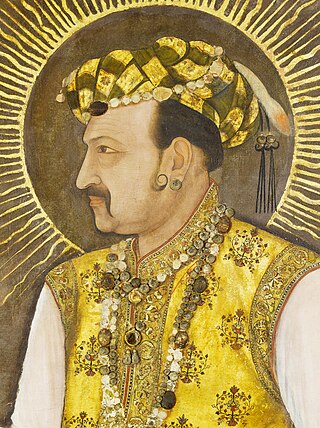
Nur-ud-din Muhammad Salim, known by his imperial name Jahangir, was Emperor of Hindustan from 1605 until his death in 1627, and the fourth Mughal Emperor.

Mirza Shahab-ud-Din Muhammad Khurram, commonly called Shah Jahan I, also called Shah Jahan the Magnificent, was Emperor of Hindustan from 1628 until his deposition in 1658. As the fifth Mughal emperor, his reign marked the zenith of Mughal architectural and cultural achievements.
Ustad Mansur was a seventeenth-century Indian painter and naturalist who served as a Mughal court artist. During which period he excelled at depicting plants and animals. He was the earliest artist to depict the dodo in colour, apart from being the first to illustrate the Siberian crane. Towards the end of Akbar's reign, he gained the title of ustad (master) and during the reign of Mughal Emperor Jahangir his masterpieces earned him the title of Nãdir-al-’Asr. Although he was largely known for his natural history illustrations, he also portrayed people in various manuscript illustrations.

Mughal painting is a South Asian style of painting on paper made in to miniatures either as book illustrations or as single works to be kept in albums (muraqqa), originating from the territory of the Mughal Empire in the Indian subcontinent. It emerged from Persian miniature painting and developed in the court of the Mughal Empire of the 16th to 18th centuries. Battles, legendary stories, hunting scenes, wildlife, royal life, mythology, as well as other subjects have all been frequently depicted in paintings.

Bishandas was a 17th-century Mughal painter at the court of the Mughal emperor Jahangir (1569–1627), specializing in portraits. Jahangir praised him as "unrivalled in the art of portraiture". Though little is known of Bishandas’ life, his name suggests he was a Hindu, like several others in the imperial workshop. In 1613 he was sent on a diplomatic mission to Persia, to paint the portraits of Shah Abbas I of Persia (1571–1629) and other leading Persian figures. Here he was so successful that he remained until 1620, and on his return Jahangir gave him an elephant.

Govardhan was a Mughal era Indian painter of the Mughal school of painting. His father Bhavani Das, had been a minor painter in the imperial workshop. Like many other Mughal painters, they were Hindus. He joined the imperial service during the reign of Akbar and he continued his work till the reign of Shah Jahan. The examples of his work that are still extant show that he was fond of rich, sensuous colour and softly modelled forms.

Farrukh Beg, also known as Farrukh Husayn, was a Persian miniature painter, who spent a bulk of his career in Safavid Iran and Mughal India, praised by Mughal Emperor Jahangir as "unrivaled in the age."
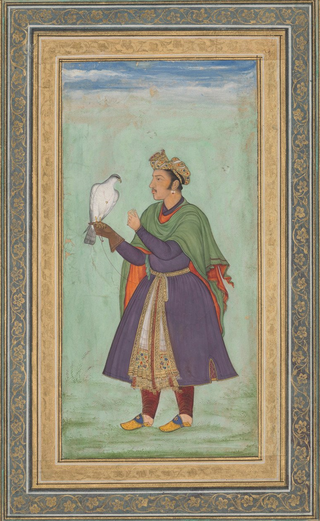
Khusrau Mirza was the eldest son of the Mughal Emperor Jahangir and his first wife, Shah Begum. The young prince displayed exceptional skills and wisdom and had the privilege to be groomed by the Mughal Emperor (Akbar) himself for the throne of the Mughal Empire. He turned out to be the most capable and qualified son of Jahangir but was befallen by an unfortunate destiny. Being Jahangir's eldest son, he was the heir-apparent to his father but Jahangir favoured his son Khurram Mirza as he held an animosity against Khusrau.
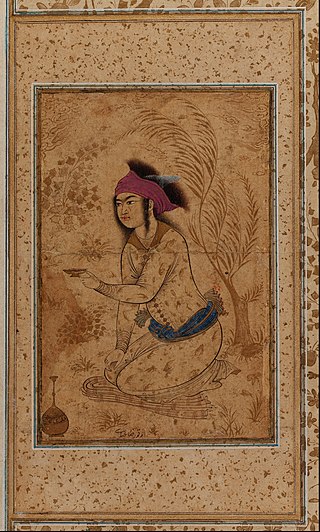
A Muraqqa is an album in book form containing Islamic miniature paintings and specimens of Islamic calligraphy, normally from several different sources, and perhaps other matter. The album was popular among collectors in the Islamic world, and by the later 16th century became the predominant format for miniature painting in the Persian Safavid, Mughal and Ottoman empires, greatly affecting the direction taken by the painting traditions of the Persian miniature, Ottoman miniature and Mughal miniature. The album largely replaced the full-scale illustrated manuscript of classics of Persian poetry, which had been the typical vehicle for the finest miniature painters up to that time. The great cost and delay of commissioning a top-quality example of such a work essentially restricted them to the ruler and a handful of other great figures, who usually had to maintain a whole workshop of calligraphers, artists and other craftsmen, with a librarian to manage the whole process.

Bichitr was an Indian painter during the Mughal period, patronized by the emperors Jahangir and Shah Jahan. The earliest known painting of his is a mature work from c. 1615.

Abu'l-Hasan entitled by the Mughal emperor Jahangir as Asaf Khan, was the Grand Vizier of the fifth Mughal emperor Shah Jahan. He previously served as the vakil of Jahangir. Asaf Khan is perhaps best known for being the father of Arjumand Banu Begum, the chief consort of Shah Jahan and the older brother of Empress Nur Jahan, and the maternal grandfather of mughal emperor Aurangzeb.

Parviz Mirza was the second son of Mughal emperor Jahangir from his wife, Sahib Jamal. His daughter, Nadira Banu Begum, later became the wife of Dara Shikoh.

Khas Mahal, meaning "the Exquisite One of the Palace", was one of the chief wives of the Mughal emperor Jahangir.
Bahar Banu Begum, meaning "spring lady", was a Mughal princess, the daughter of Mughal emperor Jahangir.
Shakr-un-Nissa Begum, also Shakr al-Nisa Begum was a Mughal princess, the daughter of Emperor Akbar.

Muhammad Daulat was a leading artist in Mughal painting, active on imperial commissions between about 1595 and 1635–1640, during the reigns of Akbar, Jahangir, and Shah Jahan. He began his career painting large narrative scenes, then specialized in portraits, but later in his career seems to have specialized in highly ornate borders to miniatures.
Hur-ul-Nisa was a Mughal princess, the first daughter of Mughal Emperor, Shah Jahan and his chief consort, Mumtaz Mahal.
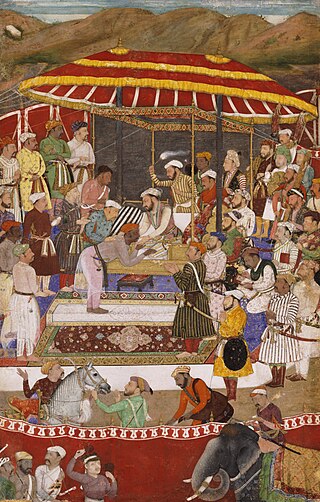
The Mughal conquest of Mewar was a military campaign led by Shah Jahan under the order of Emperor Jahangir in 1615. After a year of attrition warfare, Rana Amar Singh I surrendered conditionally to the Mughal forces.

The Muraqqaʿ-e Gulshan or Moraqqaʿ-e Golshan is an eclectic album (muraqqa) of miniature paintings, drawings, calligraphy and engravings by Indo-Persian, Deccani, Turkish and European artists.
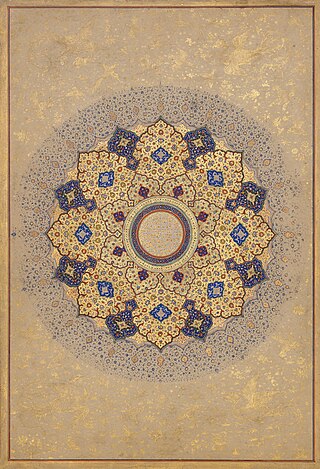
The Shah Jahan Album, also known as the Kevorkian Album or the Emperor's Album, is a series of Mughal miniatures dating between 1620–1820 from Mughal India. The album was intended for a private audience, likely consisting of the royal family and close friends. The folios are generally 15 5/16 inches (38.9 cm) by 10 1/4 inches (26 cm), however there are slight variations in height and width across the folios. The paintings for the folios were made by various artists and their workshops such as Nanha and Mansur while the calligraphic text for the folios were made by famous calligraphers such as Mir' Ali Haravi. Emperor Jahangir started the tradition of commissioning folios for the album which was continued by his successors Shah Jahan and Aurangzeb. In 1820 eleven more folios, referred to as the Late Shah Jahan Album, were added and the album was rebound. In total the album contains fifty leaves generally focusing on nature based still lives and portraits of royalty and favored members of the royal court.